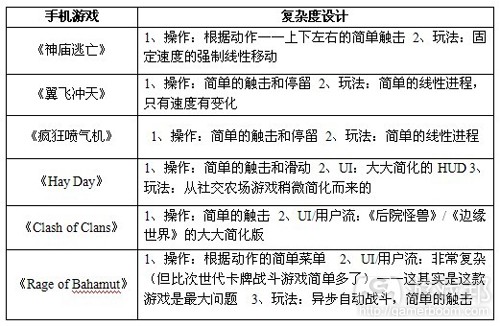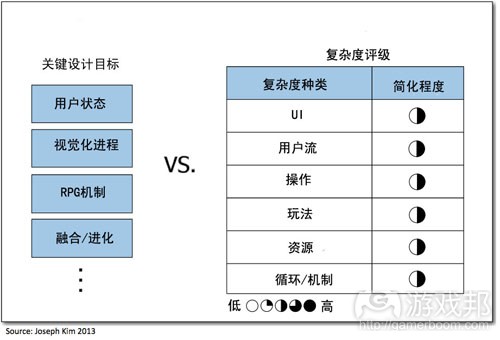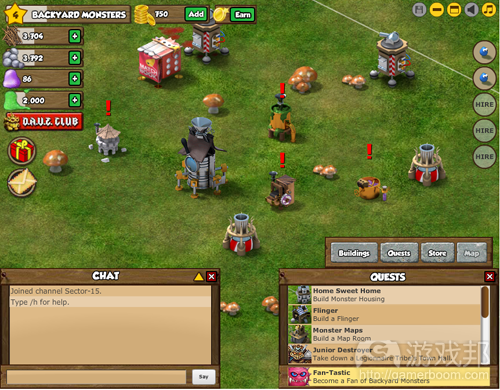你的手机游戏为什么失败了?
作者:joseph kim
设计游戏最困难的问题之一就是如何处理复杂度。
特别是对于手机,这成为一个难题是因为,其他平台的游戏(如社交、游戏机、PC和甚至掌机)都已经有不少成功的复杂度模型,而移动设备上的游戏还没有(如果我们这里所说的移动设备是特指手机)。作为比较新的游戏平台,手机使复杂度设计成为一个特别有挑战性的问题。我们一次又一次地看到行业在这方面犯错。
给小屏幕、好操作的游戏设计复杂度有多难?
事实上,非常难。
对于手机游戏,我认为复杂度可以分成以下几个主要部分:
1、UI
2、用户流
3、操作
4、玩法
5、资源
6、循环/机制
如果我们想一想现在最成功的手机游戏,我们会发现简单一次又一次地战胜复杂。
复杂度成功的案例:
另一方面。我们发现玩家也比较不能接受太复杂的设计。
然后呢?
我的观点是,在复杂度方面,你应该更加批判地看待你的游戏设计。据此我提出两点建议:
1、复杂度框架
理解你的游戏设计的核心目标是什么(或专注于你的游戏的革新设计的目标是什么)以及在保持最低限度的复杂度的情况下,你如何达到这些目标。
设计目标vs.复杂度
另外,回顾你的游戏并查看各个复杂度种类,看看是否可以进一步简化,这也是有帮助的。
2、平台的目标复杂度
确保你的游戏的复杂度设计适合游戏将发布的平台。
复杂度匹配:
正如表1所示,我们可以看到大获成功的游戏往往是那些看起来非常简单的游戏。此外,我们发现手机游戏的复杂度设计样式往往定位太高。再者,复杂度必须根据各个平台的特点来设计。
好吧,我想你现在已经知道怎么解决复杂度的问题了。现在我们来看看几个实际操作的例子。
案例1:《Candy Crush Saga》
我们想一想设计师原来是如何考虑设计的:
1、核心玩法机制:匹配三连消除
2、革新设计目标:1、《Anipong》的核心:模仿《Kakao Talk》的赢利模式 2、视觉进程:保留状态进程的地图 3、增值付费模式:休闲游戏往往能挣更多钱,因为付费、用每章节的硬门槛作为传统的免费和付费模式的替代法。4、社交整合:吸引大量Facebook用户 5、玩法变体:添加不同的玩法,如配方道具掉落、限时关卡、删除易出错的障碍,等等。
为了时间,我就不一一分析各个设计目标和复杂度的影响了……但你可以在游戏中看到开发者是如何执行各个设计目标的,总体来说,他们显然做得很好:
除了玩法,没有设计目标增加了复杂度。
为了丰富慢慢地引入新玩法类型且解释得非常仔细。
他们唯独忘了解释各种糖果组合及其用途和表示什么。
案例2:《Clash of Clans》
1、核心玩法机制:塔防(《后院怪兽》、《边缘世界》)
2、革新游戏目标:1、简化:根据手机设备的特点,简化玩法和UI 2、扩大吸引力:增加对非硬核玩家的吸引力
这款游戏其实就是做了另一款《后院怪兽》和《边缘世界》,但把它的运行平台改成手机设备,以及扩大了它的类型吸引力。开发者在设计这款游戏时始终想到降低复杂度。Supercell在这方面做得很好,各个复杂度种类包括UI、用户流、玩法等都简化了。
我们以HUD UI为例。注意:
1、与《后院怪物》和《边缘世界》相比,《Clash of Clans》的HUD元素、资源和选项更少。
2、把进攻按钮做得比其他按钮更大,把玩家的注意力引向PVP/PVE的核心循环。
3、《Clash of Clans》让玩家更容易知道游戏中正在发生什么事和可以做什么。
《后院怪兽》:
《边缘世界》:
《Clash of Clans》:
下一步:
所以,在设计游戏时要考虑到复杂度。
另外,认真考虑特殊的机制,如回合制、操作组合、剧情长度、资源数量、HUD元素,等等。
一般情况下,还要考虑不同的平台。(本文为游戏邦/gamerboom.com编译,拒绝任何不保留版权的转载,如需转载请联系:游戏邦)
Why Your Mobile Game Failed: Complexity Kills!
by joseph kim
One of the most difficult problems in designing any game is how to address complexity in the game design.
For mobile gaming in particular, this is a difficult problem as the design paradigms of successful complexity models have largely been figured out on other platforms (e.g., social, console, PC, and even game focused handheld) but not quite yet on mobile (if we define mobile to be specific to mobile phones at least). The newness of the phone platform makes this an especially challenging problem and one in which we’ve seen many industry mistakes occur time and time again (including from yours truly).
How difficult can it be to design complexity for what amounts to a smaller screen and limited controls?
In fact, very difficult.
For mobile games, I think of complexity as broken down into the following primary components:
User Interface
User Flows
Controls
Gameplay
Resource
Loops/Mechanics
If we think of some of the most successful games on mobile phones today we have seen an emerging pattern of simplicity trump complexity time and time again.
Successful Complexity Patterns in Mobile Games:
Mobile Game
Complexity Design
Temple Run 1. Controls: Simple swipe based actions- up/down, side to side
2. Gameplay: Constrained linear movement with fixed speed
Tiny Wings 1. Controls: Simple tap and hold
2. Gameplay: Simple linear progression with speed as the only variable
Jetpack Joyride 1. Controls: Simple tap and hold
2. Gameplay: Simple linear progression
Hay Day 1. Controls: Simple tap and swipe
2. UI: Greatly simplified HUD
3. Gameplay: Slightly simplified from social farm games
Clash of Clans 1. Controls: Simple tapping
2. UI/User Flows: Greatly simplified from Backyard Monsters/Edgeworld
3. Resources: Reduced to 3
4. Gameplay: Simplified city-building and tap and drop units in PVP with no micro
Rage of Bahamut 1. Controls: Simple menu based actions
2. UI/User flows: Very complex (but better in next generation of card battle games) which is actually a key problem with this game
3. Gameplay: Simple 1-tap async auto battle
On the other side, we have seen complex designs fail to resonate with users time and time again.
So What?
My point is that you should think more critically of your game design with respect to complexity. Further, two sets of recommendations based on this:
#1. Complexity Framework:
Understand what your key game design objectives are (or focus specifically on what your game’s +1 design is) and how you can achieve those objectives with the minimal amount of complexity.
Design Objectives vs. Complexity:
Further, it’s always helpful to review your application and check each category of complexity to think through whether you can additionally simplify or minimize.
#2. Target Complexity by Platform:
Make sure that the complexity design in your game is appropriate for the device the game will be launched on.
Complexity Matching:
As I showed in the Successful Complexity Patterns in Mobile Games table above, for mobile we are seeing very simple designs achieve critical success. Further, we see complexity design patterns too often shoot too high for mobile games. Again, sounding the broken record: complexity needs to be specifically designed for each platform.
Ok, I think you probably get the idea now but let’s take a couple of very simple examples to illustrate how we would use this in practice.
Simple Example #1: Candy Crush Saga
Let’s think about how the original designers may have thought about the game design:
Core gameplay mechanic:
Match-3
+1 Design Objectives:
Anipong Hearts: Monetization model that kicked ass on Kakao Talk
Visual Progression: Map with stateful progress for retention
Incremental Payment Model: Casual games typically made more money as paid, CC used hard gates for every chapter as an alternative to traditional Free and Paid models
Social Integration: To leverage their massive Facebook audience
Gameplay variation: Add different kinds of gameplay like dropping recipe items, timed levels, removing jellies, breakable obstacles, etc.
In the interest of time, I won’t break down each design objective and complexity impact… but you can see in the game how they implemented each design objective and that overall they obviously did great:
None of the design objectives increased complexity across all complexity categories except for gameplay. In fact, they were even able to reduce complexity overall in areas while still achieving their design objectives.
For the Gameplay variation objective they introduced the new gameplay types slowly and explained them very well.
The only area where they missed was the explanation of various candy combinations and what they do and how they are represented.
Simple Example #2: Clash of Clans
Core gameplay mechanic:
Tower Defense (Backyard Monsters, Edgeworld)
+1 Design Objectives:
Simplify: Simplify gameplay and user interface for mobile devices
Broaden Appeal: Broaden audience appeal to be less hardcore
In this case, the whole point was to make a game just like Backyard Monsters and Edgeworld but make it accessible to users on mobile devices and to broaden the genre’s appeal. This is an example where the whole point is to think in terms of complexity reduction. Supercell here also obviously did a great job and across all complexity categories were able to simplify UI, user flows, gameplay, etc.
Let’s just take one specific example of just the HUD UI. Notice:
Fewer HUD elements, resources, and options available on Clash of Clans vs. Backyard Monsters and Edgeworld
Attention and flow directed to main core loop of PVP/PVE in Clash of Clans via Attack button which is highlighted and much bigger than other buttons
In general, how much easier it seems to be able to grasp what is going on and what to do in Clash of Clans
Backyard Monsters:
Edgeworld:
Clash of Clans:
Next Steps:
So in thinking about your game design do keep complexity in mind.
Further, think carefully about specific mechanics e.g., turn-based combat vs. single turn automated, amount of micro vs. macro, full control scheme vs. simple controls, lengthy story vs. quick story context, number of game resources, HUD elements, etc. etc.
Each of these should vary by platform in the general case.
Good luck!(source:quarterview)













































 闽公网安备35020302001549号
闽公网安备35020302001549号